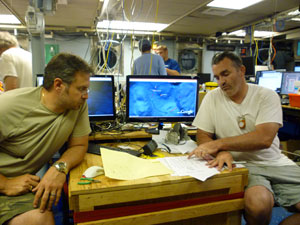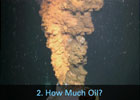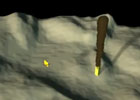Mapping and Characterizing an Underwater Plume |
|
|
 |

|
Enlarge Image Chief Scientist, Rich Camilli, a WHOI environmental engineer, and co-principal investigator Chris Reddy, a WHOI marine chemist and oil spill expert, aboard the research vessel Endeavor in June 2010 in the Gulf of Mexico. (Photo by Cameron McIntyre, Woods Hole Oceanographic Institution)
|
 | Deepwater Horizon, 2010
Principle Investigator: Rich Camilli
As the Deepwater Horizon spill progressed, it became increasingly important to know where all the oil and gas was ending up. There was a great deal of speculation and anecdotal evidence of vast underwater “plumes” of oil spreading beneath the surface, but no one had yet documented the phenomenon.
For the past decade, scientists and engineers at WHOI have been using underwater sensors to search for the chemical signature of hydrothermal vents deep on the seafloor. Recently, they had also had success mounting a highly sensitive and extremely compact instrument known as a mass spectrometer to an autonomous underwater vehicle (AUV) to hunt for faint signs hydrocarbons in the water signifying the presence of natural “cold seeps” on the seafloor off the coast of southern California.
In June, with funding from the National Science Foundation’s Rapid Response program, a team took the AUV Sentry fitted with the TETHYS mass spectrometer down to the Gulf. After detailed reconnaissance around the well with traditional oceanographic instruments, the researchers programmed Sentry to look for signs of ten different hydrocarbons, like a bloodhound following its nose in pursuit of a chemical trail.
Sentry found and tracked a continuous plume of hydrocarbons stretching southwest from the well 3,600 feet (1,100 meters) below the surface and at least 22 miles (35 kilometers) long. The scientists were then able to deploy rosette samplers into the plume and bring water up for more detailed analysis. With these, they were able to determine that the plume at the time consisted primarily of BTEX (benzene, toluene, ethylbenzene, and total xylenes) in concentrations far above what could be accounted for by natural seep activity in the Gulf.
Related Multimedia
 Science in a Time of Crisis, Chapter 3: How Much Oil?
Science in a Time of Crisis, Chapter 3: How Much Oil?
WHOI's Response to the Deepwater Horizon Oil Spill
 Sentry mapping the plume
Sentry mapping the plume
(Quicktime)
 Interview with Chris and RichInterview with Rich Camilli and Chris Reddy
Interview with Chris and RichInterview with Rich Camilli and Chris Reddy
 Press Conference: August 19, 2010
Press Conference: August 19, 2010
WHOI researchers presented the results of research conducted in the Gulf of Mexico aboard the research vessel Endeavor to assembled group of reporters at the National Press Club in Washington, D.C. .
» View Video (Quicktime)
Related NewsTracking Hydrocarbon Plume Transport and Biodegradation at Deepwater Horizon
Camilli, R. et al., Science 330, 201 (2010).
 August 19, 2010
August 19, 2010
WHOI Scientists Map and Confirm Origin of Large, Underwater Hydrocarbon Plume in Gulf
Scientists at the Woods Hole Oceanographic Institution (WHOI) detected and characterized a plume of hydrocarbons that is at least 22 miles long and more than 3,000 feet below the surface of the Gulf of Mexico, a residue of the BP Deepwater Horizon oil spill. The work presents a forensic snapshot of the plume characteristics in June and is reported in a study appearing in the Aug. 19 issue of the journal Science.
Source: Media Relations
Last updated: May 3, 2011
|  Science in a Time of Crisis, Chapter 3: How Much Oil?
Science in a Time of Crisis, Chapter 3: How Much Oil? Sentry mapping the plume
Sentry mapping the plume Interview with Chris and RichInterview with Rich Camilli and Chris Reddy
Interview with Chris and RichInterview with Rich Camilli and Chris Reddy Press Conference: August 19, 2010
Press Conference: August 19, 2010 August 19, 2010
August 19, 2010

